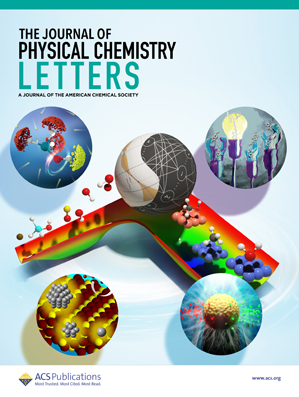Scalable Fabrication of Efficient Sky-Blue Perovskite Light-Emitting Diodes with Dual Salts.
IF 4.8
2区 化学
Q2 CHEMISTRY, PHYSICAL
引用次数: 0
Abstract
Bromide (Br)-chloride (Cl) mixing in three-dimensional (3D) perovskites provides an effective method for band gap engineering for blue emission. However, their low formation energy and poor solubility trigger rapid crystallization at room temperature, leading to extensive defect formation. Here, we introduce dual organic salts into the perovskite precursor solution to suppress crystallization and defect formation. Specifically, the tetraphenylphosphonium salt forms multiple weak interactions with lead halide octahedra, slowing 3D perovskite growth, while simultaneously directing the guanidinium slat to passivate A-site vacancies instead of forming low-dimensional perovskite. This strategy eliminates the need for antisolvent or post-treatment processes, enabling scalable device fabrication without compromising performance. As a result, sky-blue light-emitting diodes (LEDs) with active areas of 3 and 900 mm2 exhibit peak external quantum efficiencies of 13.5% and 11.2% and maximum luminance values of 5493 and 843 cd m-2, respectively. This work provides a useful route toward large-area blue perovskite LEDs.双盐高效天蓝钙钛矿发光二极管的可扩展制备。
溴(Br)-氯(Cl)在三维(3D)钙钛矿中的混合为蓝色发射的带隙工程提供了有效的方法。然而,它们的形成能低,溶解度差,在室温下会快速结晶,导致大量缺陷的形成。在这里,我们在钙钛矿前驱体溶液中引入双有机盐来抑制结晶和缺陷的形成。具体来说,四苯基磷盐与卤化铅八面体形成多重弱相互作用,减缓了三维钙钛矿的生长,同时引导胍板钝化a位空位,而不是形成低维钙钛矿。该策略消除了对抗溶剂或后处理工艺的需求,在不影响性能的情况下实现可扩展的设备制造。结果表明,有效面积为3和900 mm2的天蓝发光二极管(led)的峰值外量子效率分别为13.5%和11.2%,最大亮度值分别为5493和843 cd m-2。这项工作为大面积蓝色钙钛矿led提供了一条有用的途径。
本文章由计算机程序翻译,如有差异,请以英文原文为准。
求助全文
约1分钟内获得全文
求助全文
来源期刊

The Journal of Physical Chemistry Letters
CHEMISTRY, PHYSICAL-NANOSCIENCE & NANOTECHNOLOGY
CiteScore
9.60
自引率
7.00%
发文量
1519
审稿时长
1.6 months
期刊介绍:
The Journal of Physical Chemistry (JPC) Letters is devoted to reporting new and original experimental and theoretical basic research of interest to physical chemists, biophysical chemists, chemical physicists, physicists, material scientists, and engineers. An important criterion for acceptance is that the paper reports a significant scientific advance and/or physical insight such that rapid publication is essential. Two issues of JPC Letters are published each month.
 求助内容:
求助内容: 应助结果提醒方式:
应助结果提醒方式:


